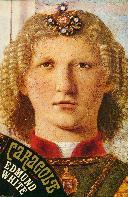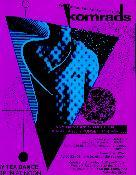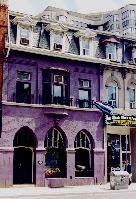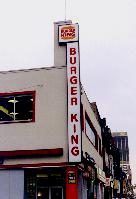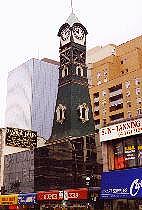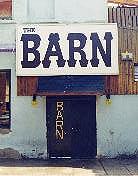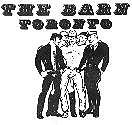|
Promiscuous |
|
But is it "gay"?
Caracole:
|
"He isn't proposing a text 'about' gayness.... What we have instead is a gay geography of the whole city.
"White is simply making the assumption that the gay version of the world is a true one; oblique maybe, but precisely because of that informed, revealing, powerful."
Neil Bartlett on Caracole
in The Body Politic,
April 1986.
1986
January through April
In January Neil sent me his review of Caracole. It was rich, long, deliciously convoluted -- too much so for some people at The Body Politic who, looking over their shoulders, thought we were becoming yet again too erudite for a "popular" audience.
The manuscript was, as all were, circulated around Midmag for comment. "Cut the gush," one member wrote, "otherwise fine." Another agreed but added a nice flourish: "It's overall wonderful and swishy."
None asked: Is this book gay? Others had. Neil noted a "disturbed journalist" who'd confronted him: "I've heard Edmund claim that his next novel will be all about heterosexuals. It isn't true, is it?" It was, but as Neil said, "there's more to it than that." The story was set in what might have been Renaissance Venice, Paris under the Nazis, even modern Manhattan.
The city, Neil wrote, had "culture, cafés, crumbling palaces, white painted loft apartments in the more dubious but affordable parts of town, and extensive and pointless carnival, with gorgeously overdressed men and women, fresh seafood, handsome waiters ... every delight that the discerning faggot could ask for."
But it had no gay ghetto, not even any gay inhabitants.
- "The world may be scrutinized by means of 'realism,' but if it's to truly reveal the cracks and flaws in its mechanisms, then it may be scrutinized by a fantasy populated entirely by those unreal characters, heterosexuals.
"Only a gay author can see how fantastic their world is.
"For this affront the book has been slaughtered by critics, straight and gay. How dare he write about us / them?
"There you have it: there is the large, adult world of Life and its Arts, important, secure and profitable; then there is a minor department of life called 'the gay world.' We are supposed to sigh with relief now that one of 'our' authors has grown out of this smaller world into the larger World. The news from White, however, in this generous, glorious new text, is that there is only one world.
"That is why his city has no gay suburb through which we can pass. He isn't proposing a text 'about' gayness -- a text which requires that gayness be a limited subject, a problem to be treated and fictionally resolved, a malady to be chronicled, a case history to be detailed. What we have instead is a gay geography of the whole city.
"White is simply making the assumption that the gay version of the world is a true one; oblique maybe, but precisely because of that informed, revealing, powerful."
Yes! I made sure Neil's piece ran with most of its "gush" intact. It appeared in the April 1986 issue, with a big picture of Ed in Paris and a Venetian interior painted by John Singer Sargent in 1899. It ran to three full pages.
And if some people don't like that, I thought, well tough.
Neil had told me more about The Magic Flute, Papageno and Papagena both played by men, "one wearing a coat of feathers over a naked chest, one in heels and a Dusty Springfield black lace maxi dress, screeching at each other like mating birds and singing sweetly about their hopes that their marriage would be blessed with many children. My mother loved it."
He also said my letters were "always graced with lovely boys who are entrancing you from a distance. What's going on???"
- January 22, 1986, to Neil:
The Flute sounds incredible (perhaps in the literal meaning of the word!), not simply the details but the way it let you touch such profound feelings about your own life. I suspect that's part of what I'm going through, too.
That's what's going on with all those lovely boys who entrance me without finding their way to my bed. Aside from their individual qualities -- charming, funny, pained, messy, beautiful -- they are for me symbols, I guess, of all that's delicious in the way we've been able to live: their physicality and grace and inventiveness; their oddly modest sureness about how good they are on the dance floor; the freedom they take to make an environment their own.
Mind you, we've had a lesson in how temporary and borrowed our spaces can be, however much richness we might give them when they're ours: Cornelius has closed, quite suddenly. My dream boys and I are in mourning.
Changes (The Avalon when you were here) is closing in March, along with the seedy, history filled Parkside, to be replaced by a Burger King. So we joke about "Bugger King" and ponder which of the other bars, most of them new, most of them tacky, can be made to provide the occasional magic Cornelius did.
And it's not that I just watch, Neil.
Last night I picked up by small steps a man I'd seen around and always thought oddly dangerous looking: a Nietzchean moustache and something curious about the eyes. I got a ride home and we played in the car until he gave up his unsureness about coming in.
We talked curled up for two hours before I got to finish the blowjob I'd begun in the front seat. Much as I love sucking cock, it wouldn't have mattered if I hadn't finished it.
He was surprised at being found dangerous looking, finds himself, as so many of us do, not very attractive, unsure what it means when others think he is. He talked about how he sings to himself when he's home alone (as I talk to myself out loud); talked about how, as a bartender at 18 East, he remembers who asks for which beer and how even in other bars he'll look around and say: "He's an Export, he's a Miller, he's a Blue."
He'd shift his leg against mine, rub a foot against mine, still in our socks, still in fact fully dressed, and talk -- talk just as Ed White said in States of Desire that people can talk to each other at the baths: We curl up on a couch with a stranger and tell him everything. Set this up against the myth of heartless, inhuman, irresponsible "promiscuity" we're now being sold as the revisionist history of our own lives.
Ah, but I'm wandering into one of those articles screaming to be written, and telling you, who knows all this -- all the richness of our messy and randomly affectionate lives -- very well.
|
More new joints
Design for the Jetsons:
Sinful pleasures:
Bid for the bereft:
Ever changing; ever the same:
|
Brothers
Yes, there was "gay TV" before Ellen. If Brothers sounds like Will & Grace -- with a queen for comic relief, a "straight looking, straight acting" lead to keep it safe -- well, it was.
Komrads was the best try, a dazzling Russian Constructivist design by Chris Lea, once with TBP (and later president of the Green Party of Canada; we did have odd careers). It had the biggest dance floor in the city, stainless steel. Each of its small black tables was lit by a single straight down pin spot, a facetted ashtray set dead centre catching the beam, the space full of multi coloured jewels glowing in the dark. There was a small café; Gerald Hannon later reviewed it for Xtra. "Design the Jetsons would love," he said (Chris Lea once his boyfriend) "but the food is for the Flintstones."
Just after Christmas Colby's launched at 5 St Joseph, once Katrina's / KT's, with Voodoo / Club Doc / Backstreet upstairs. That second floor would become Bachelors, brief attempt at a no smoking venue. The ashtrays were back out in a week; later the place would feature even more sinful pleasures.
The premiere of Showbiz, down at Yonge and Gould just north of Dundas, had been announced for the same time, but it took three more weeks to open. It was a long, second floor space also with a café, but mostly dedicated to dancing. Its management made a clear bid for the now bereft Cornelius crowd, with tea dance on Sundays and a DJ once famous at The Carriage House.
In time it would get that crowd, or some of them -- I did later see a few lovely visions there -- but it hadn't quite yet.
- January 29, 1986, to Jane:
Well, if Cornelius is closed there are other bars -- even if Kevin Bryson hasn't yet found one he likes dancing in.
Trax, despite its name (so many bars here are named for American ones), is quite unusual: a high ceilinged room at the front where disco blares; a much cozier one at the back where you can hear none of that, but instead a piano around which aging queens, a few in bits of leather, gather and wail Broadway tunes at the top of their lungs.
Kevin Orr, Craig Patterson, Gillian Rodgerson and I all went there after last week's editorial meeting and caught it in full swing, the whole room singing "Tonight" from West Side Story, complete with harmonies provided by operatic tenors to what, Craig said, can otherwise sound surprisingly like the Red Army Chorus. Gillian, quite amazed, said it would never happen in a lesbian bar -- but then it would never happen at Chaps, either.
At Trax I can feel very young. A lovely duo came up to me there last week, the older 72 and suave, the younger 45, kind of pretty and very drunk. The older hailed a man in a fur hat who must have been his senior by at least a few years ("Ah, my old auntie! Perhaps he'd like to go with me to Barbados next month -- and pay for the trip"), leaving me to the sweet drunk.
I liked him, if without wanting any more to happen; making both these facts clear took about another hour and I'm sure looked quite cozy to those who might have been watching.
At 11 the bartender turns down the music and turns up the TV so we can all watch the latest episode of Brothers, the US sitcom CityTV is running, in which one brother is gay and has a friend who is an outrageous queen. The whole bar roars in basso profundo.
Trax was at 529 Yonge, across from The Parkside in the space that had been Gunsel's in 1980. The building dates from the late 19th century, said to have begun as a funeral parlour, its big gothic windows giving that some credence.
After Gunsel's it was Derringers, then in May 1984 The Hitching Post, its ads featuring a genial cartoon cowboy. It would soon push the point with a bit of cowboy diction, changing its name to The Hitch'n'Post.
By August 1984 and under new management it was Trax, sharing a name if little more (the occasional joint ads and double addressed matchbooks) with Trax San Francisco, later I think Tucson. Xtra announced it as part of an "Ivory Epidemic," pianos showing up in bars all over town.
The story also noted its windows on Yonge, rare then, many gay bars just a door on the street, the few outdoor patios hidden behind the building or in high fenced courtyards. At first those windows had tinted mylar shades: you could see out; no one could see in. But in time we'd be drinking in full public view.
Trax was ever changing. In early 1986 it expanded to its second floor, a restaurant at the front and a pool table at the back -- or vice versa; they would swap spaces more than once. A year later the place would break through the roof with a two level outdoor deck.
The crowd changed too but never lost its odd mix. For a while drag queens were barred; in time they'd become and remain a fixture, a stage provided for shows.
More than 15 years later Trax would still be there, still changing but of course remaining much the same, with men of various ages in leather, cowboy boots, office drag, and frocks -- if without the piano. (For a time; it would return.)
- Well, Sunday evening, February 2:
(to Jane; that January 29 letter continued)Last night's bar was The Barn, but if I go into all that this letter will never end. Suffice it to say that people are not always what they seem: the unapproachable bearded blond with the nice forearms finally gets approached when I run into him for the nth time and have to laugh. He becomes an eagerly friendly boy named Chris who's moved here with his lover from Halifax, and who's been a butcher since he was 13: he shows me where a piece of a finger is missing to prove it.
His lover and he are a little confused about how they plan to end the night, trying to give each other space in what isn't a big bar. Chris's evening does not end with me, as it had seemed it might, but on the way out I run into his lover, Darryl, and have an excuse to talk to him too, introduced at a distance, as it were. He's dark haired and sparkly, as affectionate as Chris.
As I leave they're dancing together quite happily; whatever confusion they might have had about what they wanted to find at The Barn seemed resolved. They were a joy.
Later, waiting for the night bus, I stand beside two men, one maybe 30, the other younger, who it becomes clear had picked each other up at Komrads. We don't talk but I do eavesdrop, smiling rather stupidly at the tentative, generous conversation of two men getting to know a little about each other before going home to bed.
"Where from in Saskatchewan?" I hear the older one say. "Moose Jaw," says the younger, and they discuss the relative populations of cities. I walk home smiling, as you know I've done before, at what I've been privileged to see, and get to bed at 4 am.
For more on the "faceless sexual stereotypes" of William Hoffman's 1986 play As Is, & my response, see Sex: From erotic life to death by banality.
He goes on to retail titillating adventures in which no other people appear -- except as faceless sexual stereotypes: men in the tubs at the Mineshaft; a subway john full of horny high school students.
As I said to Jane: "The tourist version again, here as a nostalgic elegy for a way of life now extinct. Yet it's not extinct. I'm left wondering why so many of us are so willing to screen the details of our own lives through the filter of mythology, hot, horny, and empty."
|
Main drag farewells
Bugger King:
Under the clock:
|
Old haunts commemorated
(& not)
On Changes' final night, dancers could get a souvenir T-shirt listing the site's various incarnations since the late '60s: The August Club, August 2, Mama Cooper's, The Milkbar, Quasimodo, Bimbo's, Stages, Avalon, Changes -- under them all: "The last dance, March 1, 1986."
The unrecalled upstairs of The St Charles had been: The Maygay; Charly's; The Y Knot; Jocks; Charley's (again but with an "e"); finally Billy's. Xtra had fun with the final listing: "3 bars, lounge, pool table, pinball, male dancers; free wieners (hot dogs)."
|
The Bar (For years)
Bad rep:
Despite rumours of its impending doom, The Barn remains in 2003. The oldest surviving gay bar on Church St, its look is much the same if, on some nights, its crowd as much queer raver boys (& girls) as clones. |
"And it's terrible," he wrote, "that The Parkside is closing, it should be declared a Canadian National Monument. I hope you will write magnificent obituaries for them all. The next time you're there, pour a small libation on the ground for me." It was John Allec, not I, who wrote an obit for The Parkside. It appeared in the March 22 issue of Xtra, the place closing along with Changes on March 1.
John, in town only since 1980, had seen just the last few years of The Parkside. But even so, he wrote: "I think I've had more good times there than at any other gay bar in town, and that was only after its golden days in the '70s as the place to hang out for almost everybody." That last Saturday afternoon the crowd was SRO (if patrons were at last allowed to stand up with a drink), old habitués lifting ashtrays and draft glasses as souvenirs. "I opened this place," one dowager in widow's weeds said, "so why the fuck shouldn't I close it?"
But the highlight came when three uniformed cops walked in -- and the crowd greeting them with wild applause. Why not? "The cops have been regulars there as much as anybody," John wrote, "and the ceremonies wouldn't have been complete without their dropping in to pay their last respects."
The Quest would close six months later, despite a last ditch effort: it had begun advertising in The Body Politic -- for the first time in that bar's long life -- only two years before.
The St Charles would go too, at last and unmourned, in October 1987. Xtra would mark its passing not with the nostalgia it had shown for The Parkside but with a photo of "Toronto's oldest and least loved gay watering hole." Its owner Norm Bolter had once evicted Xtra from the premises, saying no one there read it -- and "besides, it makes a mess." "A mess?" the little paper piped back. "In The St Charles?"
With the bar would go its upstairs dance spot, too. The guarded brick facade of The St Charles would be opened up and glass storefronts installed, a few tatty discount shops behind them. The clock tower remained, a landmark with nothing left to mark.
With that, all the old gay bars on Yonge Street would be gone, leaving only Trax to hold a spot on the city's main drag. The scene has shifted east, to Church -- a street that, in the mid 1970s, had been home to just one gay venue: Les Cavaliers, in an old three storey structure likely built as a hotel, at the corner of Granby Street south of Carlton.
In 1981 its proprietors had also opened a place farther up Church, at number 457 -- a gay historic site: in the mid '60s The Melody Room and office of Two, one of the city's first if short lived gay mags.
They named that place Together (said to be a play on "To get her"), open to both men and women and offering a menu familiar from Les Cav: Eastern European, as Janko Naglic himself was (his staff dubbed his style "Dubrovnik chic"). By 1985 Together had morphed to Private Eyes, then Together Again (sic), all the while serving mostly women, as had Jo Jo's over Les Cavaliers, briefly, in 1976.
But just as at Jo Jo's, Janko seemed ambivalent about a lesbian clientele. He briefly called the place The 457 Together Again, but soon it was just The 457, its listing in Xtra saying "for men." It would later get more clearly butch, as Tanks, camouflage netting key to its decor; later still it would be The Bulldog. In 1997, under new management, it would be The Black Eagle, surrounded then by a slew of gay bars and restaurants running north along Church from Alexander up beyond Wellesley.
The Barn was born farther south and much earlier: in 1977 it still stood alone as a gay bar on Church Street. Its corner entrance still carried a sign for Les Cavaliers, though in 1985 the ground floor was briefly renamed Club Ivory, "a piano bar for discerning women; dress code in effect" -- an odd echo of Jo Jo's and it lasted no longer.
By 1986 that space was little more than a downstairs annex to The Barn. In 1991 it would be renamed The Stables; at the same time the third floor, first opened in 1988, got called The Harness. But, just as at Chaps in 1983, such distinctions made no impression on the clientele: it was all just The Barn.
Women could be there, but it was visibly meant for men. Its ad image and a big matching poster inside showed five appropriately attired hunks done in the exaggerated, hypermasculine style of Tom of Finland and with his usual mark of butch camaraderie: playful, knowing grins.
You could go in through that corner entrance, but most people used the door around the side, on Granby. There the sign said "The Barn" -- for a long time in barn board. Inside, stairs led to the second floor and the first of its three spaces.
In fact it was a row of three buildings, archways knocked through their bearing walls making it easy to circumnavigate the whole place. After 1988 you could include the third floor in your travels, stairways north and south making it part of the circuit.
On the second floor the first space was the main bar. In the next was a beer cooler; another cooler bar in the third. Between, flanked by vertical bars that held shelves just wide enough for a beer bottle, there was the dance floor, not large and often packed.
A passageway behind led to the washrooms and a door out to the back deck, both the loos and that deck notorious for sex, usually covert but not always. The place was painted black; but for a few pin spots, the glow of beer cooler signs and lights flashing off the dancers, it was dark.
The Barn had a bad reputation even among many gay men. It might have served as the model for what people often imagine a gay bar to be: grim, grotty, dehumanizing. Even a bit scary.
But get to know it -- its clientele, its staff, its rhythms over the course of a week or even a single night -- and you could find something else entirely. With Cornelius gone, The Barn became for many of us, myself included, The Bar.
There I found familiar faces and bodies, Kevin Bryson's among them if too confined by the tiny dance floor to really cut lose. That sometimes left him chatting with me, the two of us treating each other as green islands of conversation from which we'd head out and return, taking spins through the dark alluring sea.
"The Barn," I told Jane, "is almost comically dark; that and the bars confining the dance floor contrast with how friendly the bartenders and many of the patrons are, making the whole thing seem a parody we've outgrown though still, with a kind of amused tolerance, enjoy.
"And it's more fun to me than the disco at Chaps, where, I joke to friends, people have sublimated sex in shopping for clothes."
Early in the year I'd tried to buy poppers at my usual location, the coat check at Chaps. But they couldn't sell them anymore. Federal health officials had declared butyl nitrite a restricted drug -- a bit late if they were after a putative "lifestyle" cause of AIDS, but then Canada was always late dealing with even more proven causes, not to mention treatments later on.
In any case the effect would be short lived. Enforcement was in provincial, not federal, hands. Ontario complied, but you could still get poppers in Quebec. Mail order houses there made a fortune shipping little brown bottles at $12 apiece to tight assed Toronto. It was still the cheapest high you could find (and very good for tight asses, too). I bought my next batch in Montreal.
That was in March, on a business trip there with Merv Walker and his lover Tom Shaver. Montreal and I had never much got along. In my few visits there over the years I'd never learned its style -- let alone its language, increasingly French as Anglo power was pushed aside.
I had never learned its scene either, the gay night life that for years had made the city famous as party central, Toronto by comparison -- any Montrealer would gladly tell you -- a deadly bore.
On that night in a Montreal strip bar I was being a tourist -- free as any tourist is to gawk at native rituals with amused disdain, having no need to grasp what they might mean.
Years later I'd be not a tourist in such places but an inhabitant: dancing boys not merely a show, but my fellow citizens.
- March 29, 1986, to Jane:
One night we all went out, but Tom and Merv left me at K.O.X. around 1 am. I chatted up a man who seemed promising (literally) until he said I'd have to find him a joint by closing if I wanted to go home with him. Being no good at finding joints even where I speak the language, I was abandoned at 3 am with six dollars in my pocket and four miles from Outremont [staying there with friends]. On top of that, it was snowing. I walked, cursing.
Still, K.O.X. was interesting (if in that particular case a bit infuriating). It's quite imaginatively designed, using big black oil drums piled up as dividers and setting up the washroom as one of those circuits people constantly wander in bars: a novice (which I was) can find himself there without knowing that's where he was headed; up a ramp and there you are; keep walking past the urinals and you're out again, no doors blocking your way.
As with The Barn, this self consciously "dirty" atmosphere ends up being mostly amusing, and like The Barn its reputation, if not its entire reality, is leather. I'm lately finding such places more comfortable than "polite" dressy bars. Leather, which on the face of it can seem an outrageous pretense, in fact crosses the line into self parody.
A man in chaps knows, at heart, that he's wearing something silly -- and blatantly sexual. A boy at Chaps in Gucci loafers, Calvin Klein jeans and an Italian knit pullover just might expect you to take them seriously -- and just might pretend offence if you suggest he intends his style to be erotic.
Tom, Merv and I also went to one of those Montreal bars where boys take their clothes off. I'm told by Kevin Orr, a connoisseur of such things, that we didn't find the best one, but I suspect they're all of a piece. There was a little stage with a doorway behind it draped in beaded strings, on one side a rope the dancers would haul up and lean out on -- a routine the go go boys at The Manatee were refining back in 1972.
These dancers were also the bar's waiters. They would, for a fee, dance at your table, bringing with them a little platform -- actually a wooden cable spool with the club's name spray painted on it -- that they'd stand on to get the right altitude, and gyrate. They all wore little nylon G strings with leopard skin patterns, and after dancing would wait on tables in these things, their tight, tanned bums sticking out.
I did wish for a nice pair of Jockey shorts, I must say. Parody here seemed not self consciously humorous enough. And a dick, after all, is a dick, even if it's waving over your beer. Curiosity is satisfied pretty quickly, and you can't satisfy anything else without waiting around till closing time and parting with a lot more money. (If, indeed, you're satisfied then.)
I was being a tourist that night, free as any tourist is to gawk at native rituals with amused disdain, having no need to grasp what they might mean.
Many years later I would be not simply a connoisseur of such places but an inhabitant, dancing boys not merely a show but my fellow citizens. That future would have seemed unlikely to me in that club in Montreal, but my final words about it to Jane perhaps foreshadowed what I would eventually come to know:
- The most interesting thing was watching these boys leave the stage. The clichéd routines would be shut off, these kids would reach down and scoop up their discarded jeans and saunter through the beads -- which led only to another part of the bar where you could still see them, bored naked boys hooking their G strings back on, maybe putting on their pants.
That, not surprisingly, was the most erotic sight in the place: not actors any more, just boys getting dressed, their bodies their own, their cocks just something to be arranged in their clothes.
And it certainly was: I've always loved competence, self assurance, comfortably engaging faces, & pert little butts.
- Andy, as it turned out he was called, was standing with a friend and I wasn't sure (as no one can be in that dark place) if he was noticing me noticing him or not. When I finally found a space beside him he said hello, and his friend -- apparently by design -- decided it was time he left.
They were both on tour with a dance company from Los Angeles, the friend a dancer, Andy a technician and roadie. We ended up back at his room in the Carlton Inn for what might have been no more than a fuck but which became hours of affection, talk, surprising warmth. "A good fit," he called it, and it certainly was.
Andy was more than a roadie. At the hotel I'd see people come up to him with problems, knowing he could put things right. "I'm kind of a daddy to them," he said, all of 29 himself, a sweet, compact guy with a neat round bum, a straw thatched head and a gamin charm behind which lived a strong and unfussy man.
I've always loved competence, calm self assurance, comfortably engaging faces -- and pert little butts. We had such a delicious time that we made a date to do it again. Heading off to meet him the next night I felt every inch the model of the modern homosexual, carting a pack of Marlboros (his brand; he hadn't been able to find them), a six pack of beer and a dozen condoms.
By then I was hardly "the only faggot in town with condoms." Andy and I put them to good use, if not using up all dozen. He packed the leftovers in his bag to amuse US Customs.
Go on to 1986: May through December
Go back to Contents / My Home Page
This page: http://www.rbebout.com/bar/1986a.htm
December 1999 / Last revised: June 22, 2003
Rick Bébout © 1999-2003 / rick@rbebout.com
